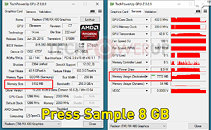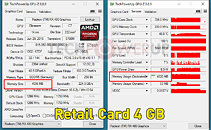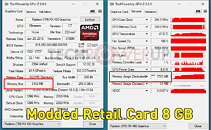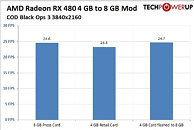Tuesday, July 5th 2016

AMD Retail Radeon RX 480 4GB to 8GB Memory Unlock Mod Works, We Benchmarked
Earlier this week, we heard reports of some early adopters of the 4 GB variant of AMD Radeon RX 480 claiming that their cards shipped with 8 GB of memory physically present on their cards, but their graphics card BIOS somehow prevented the GPU from addressing more than 4 GB of it. In its Reddit AMA, the company presented a vague answer to the question of whether such 4 GB cards are moddable to 8 GB by flashing it with the BIOS of the 8 GB variant, by stating that the ability to mod is restricted to review samples. This is both true and false. Short answer: retail 4 GB RX 480 can be flashed to 8 GB, and the modified card perfoms on par with the 8 GB variant.
AMD sent out review samples of the 8 GB variant, and to enable reviews to also put up reviews of the 4 GB variant, it sent a special BIOS that converts the 8 GB card to 4 GB, by reducing its address-space and memory clocks, perfectly simulating the 4 GB variant. AMD's claims of 4 GB cards with 8 GB physical memory being restricted to review samples was proven false when early adopters of retail 4 GB cards discovered eight Samsung 8 Gbit memory chips on their card amounting to 8 GB. We currently have an AIB partner-branded retail 4 GB Radeon RX 480 card which we bought online (invoice posted), and which we're using to prepare our 4 GB RX 480 review. We first discovered that our 4 GB retail card had the same exact Samsung 8x 8 Gb chips (including the same bin, specc'd for 8 Gbps) as the 8 GB card. We flashed this card with the 8 GB card's BIOS, and were successful in doing so. The trick here is to extract the BIOS of the 8 GB card with ATIFlash 2.74 and then transplanting that BIOS onto the 4 GB card. The 8 GB card BIOS image which we used, can be found here. Use at your own risk.To confirm that this mod works, we first tested our 8 GB review sample with its untouched 8 GB BIOS, and used that as control. Next, we tested the retail 4 GB card with the BIOS it shipped with. Lastly, we flashed this 4 GB card using ATIFlash with the 8 GB BIOS, which we extracted from our 8 GB card using ATIFlash. We ran "Call of Duty: Black Ops III," on the three. This game can consume dedicated video memory beyond 4 GB at 4K Ultra HD (3840 x 2160).
The 8 GB control and the modified 4 GB to 8 GB card performed on-par with each other. The 8 GB control card produced 24.6 fps, the 4 GB to 8 GB modified card produced 24.7 fps. The 4 GB card with its original retail BIOS produced 23.3 fps. To make sure that each GPU runs at a predictable GPU frequency (usually thermal and power limit reduces clocks), we've set both fan and power target to maximum, which results in a constant frequency of 1266 MHz on both cards.Also, to prove that the game-test (COD: Black Ops III) was able to consume more than 4 GB of video memory on the modified card, as it does on our 8 GB control card, we observed the "Memory Usage (dedicated)" graph of GPU-Z. The modified card was indeed able to address >4 GB of video memory on the card, just as it does on the 8 GB card.
In conclusion, flashing the reference 4 GB Radeon RX 480 to 8 GB works, if you're sure your card has 8 GB of memory physically present. Sadly the only way to know for sure is disassembling your card, which will definitely break some seals and void your warranty. You also need to be sure how to use ATIFlash correctly.
AMD sent out review samples of the 8 GB variant, and to enable reviews to also put up reviews of the 4 GB variant, it sent a special BIOS that converts the 8 GB card to 4 GB, by reducing its address-space and memory clocks, perfectly simulating the 4 GB variant. AMD's claims of 4 GB cards with 8 GB physical memory being restricted to review samples was proven false when early adopters of retail 4 GB cards discovered eight Samsung 8 Gbit memory chips on their card amounting to 8 GB. We currently have an AIB partner-branded retail 4 GB Radeon RX 480 card which we bought online (invoice posted), and which we're using to prepare our 4 GB RX 480 review. We first discovered that our 4 GB retail card had the same exact Samsung 8x 8 Gb chips (including the same bin, specc'd for 8 Gbps) as the 8 GB card. We flashed this card with the 8 GB card's BIOS, and were successful in doing so. The trick here is to extract the BIOS of the 8 GB card with ATIFlash 2.74 and then transplanting that BIOS onto the 4 GB card. The 8 GB card BIOS image which we used, can be found here. Use at your own risk.To confirm that this mod works, we first tested our 8 GB review sample with its untouched 8 GB BIOS, and used that as control. Next, we tested the retail 4 GB card with the BIOS it shipped with. Lastly, we flashed this 4 GB card using ATIFlash with the 8 GB BIOS, which we extracted from our 8 GB card using ATIFlash. We ran "Call of Duty: Black Ops III," on the three. This game can consume dedicated video memory beyond 4 GB at 4K Ultra HD (3840 x 2160).
The 8 GB control and the modified 4 GB to 8 GB card performed on-par with each other. The 8 GB control card produced 24.6 fps, the 4 GB to 8 GB modified card produced 24.7 fps. The 4 GB card with its original retail BIOS produced 23.3 fps. To make sure that each GPU runs at a predictable GPU frequency (usually thermal and power limit reduces clocks), we've set both fan and power target to maximum, which results in a constant frequency of 1266 MHz on both cards.Also, to prove that the game-test (COD: Black Ops III) was able to consume more than 4 GB of video memory on the modified card, as it does on our 8 GB control card, we observed the "Memory Usage (dedicated)" graph of GPU-Z. The modified card was indeed able to address >4 GB of video memory on the card, just as it does on the 8 GB card.
In conclusion, flashing the reference 4 GB Radeon RX 480 to 8 GB works, if you're sure your card has 8 GB of memory physically present. Sadly the only way to know for sure is disassembling your card, which will definitely break some seals and void your warranty. You also need to be sure how to use ATIFlash correctly.





110 Comments on AMD Retail Radeon RX 480 4GB to 8GB Memory Unlock Mod Works, We Benchmarked
What about vram clock speed? Wasn't the 4GB supposed to run slower?
nice! thx for testing! god, its starting to feel like good old mod times
Link: github.com/caa82437/PolarisBiosEditor
www.overclock.net/t/1604686/polaris-bios-editor
What is wrong with these people?
AMD had only one product for certification and testing, which is cheaper then having two separate production lines. When the custom versions are coming you will see real 4GB cards.
Anyway this does bring back lots of memories. I remember unlocking my 9500 to 9700 back in 2003, glorious days!fanboys, need I say more? Just ignore some comments.
Though it's amusing that people cannot see logic as it stares them in their red little faces. It's as simple as this. I buy a 8gb card for 'x' amount but the same card is sold at '<x' with bits simply hidden. People in the know can just enable the extra 4Gb and have the same card I paid extra for. It's not a scam but it's fucking lazy of AMD.
But I do love seeing how people see this as a positive (which it is if you are in the know) when people are being sold the 8Gb identical card for more money.
But, in the interests of balance, it's not anywhere near as bad as Nvidia selling a Titan at the price they go for (when they release a faster version 2 months later as a xx80ti). I can say bad things about both sides - I see a lot of people here unable to say anything bad about team red or green - that be a fanboy.
So is it fair that people have rushed out and bought an 8Gb card and paid more for it because it has 8Gb when the cheaper card is also an 8Gb card but AMD didn't tell anyone? If you think that's fair - you're a douche.
However as DX12 and Vulkan begin to be better utilized by game studio programmers 8 gb and up will certainly will make a difference.
VRAM is among other things a page buffer. 4k video requires 199MILLION bits for every pixel per page. So do the math. Memory bandwidth per second in the RX 480 is 320 gb/second.
Consider the bucket analogy; 8gb of memory is just using a larger bucket to fill with the SAME volume of water that 4gb vram is capable of.
More Vram provides more "pipelines" to fill that bucket but if the bottleneck is the CPU then more VRAM will make no difference.
The Media benchmarking writers just do not want to provide accurate information to the consumer. So while buying 8gb of RAM for $29 might get you a percentage point increase in performance over 4 gb, the consumer just needs to know the value of that additional performance.
So for any given percentage in performance increase what would be your willingness to part with your cash?
Would you spend $300 to gain a 2-10% increase in performance?
Would you spend $29 to gain a 5% increase in performance? 8gb VRAM certainly future proofs your GPU investment for a very small outlay in cash.